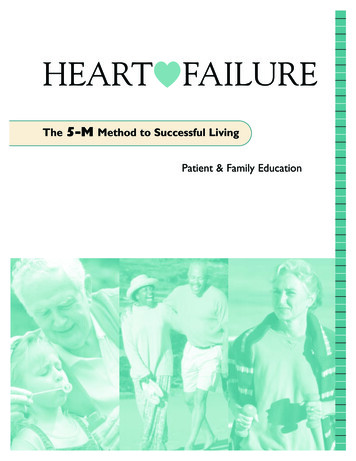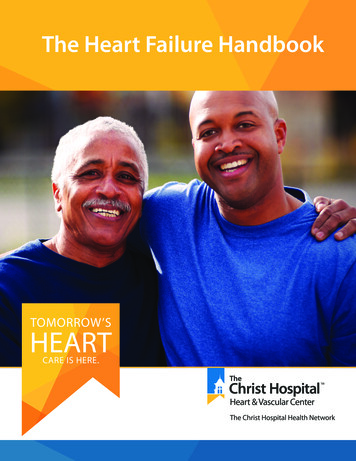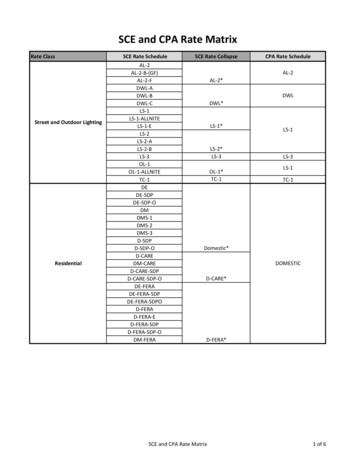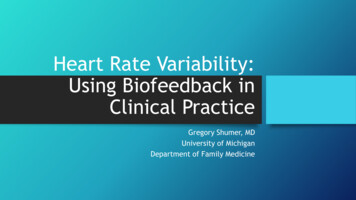
Transcription
Heart Rate Variability:Using Biofeedback inClinical PracticeGregory Shumer, MDUniversity of MichiganDepartment of Family Medicine
Outline Introduce Biofeedback Discuss Heart Rate Variability Physiology Research & Evidence Discuss Concept of CoherencePractice ExerciseCase StudiesConclusion
Introduction: Biofeedback Biofeedback What is this? What are some examples? What is it used for?
Introduction: Biofeedback Biofeedback: A type of therapy that teaches aperson to change and controlphysiological processes throughpractice The practice involves providing traineewith instantaneous electronic displayof a physiologic function, andproviding techniques to help them tryto change & improve the outputLehrer et al
Introduction: Biofeedback Types of Biofeedback: EMG Muscle Tension Headaches, incontinence, TMJ dysfunction, fibromyalgia and musculoskeletalpain disorders Finger Temperature Thermal Biofeedback Stress and anxiety, Raynaud’s syndrome EEG Neurofeedback ADHD, anxiety disorders, PTSD, insomnia Heart Rate Variability Depression and anxiety, asthma, cardiovascular disease, hypertension,fibromyalgia and musculoskeletal pain disordersGlick and Greco
Goals of Biofeedback1. Education about connections between patient’s symptoms and physiology2. Skills training in changing biofeedback signals corresponding to physiologicprocesses (example: HRV)3. Development of awareness of internal states linked to arousal andrelaxation4. Application of skills training to carry-over in recognizing and modifyinginternal states without aid of instrumentation5. Development of sense of self-efficacy and empowermentGlick & Greco
Clinical Sessions Initial Session Interview and assessment Build therapeutic relationship Educate on plausible relationshipregarding psychophysiology andbiofeedback, and how it relatesto patient’s symptoms Engage patient in treatment The patient acceptsresponsibility for practicing athome (ideally daily)Glick & Greco Subsequent Sessions Discuss how practice is going athome Discuss any change in symptomsor other changes perceived bypatient Engage patient in biofeedbacktreatment (usually they sync andrespond more quickly) Eventually, patient is aware ofinternal states, and equipment isnot needed
Clinical Applications Depression, Anxiety, and other mood disorders (PTSD, OCD, panic) Situational Stress Test and performance anxiety Insomnia Agoraphobia or other situational anxiety disorders Chronic pain conditionsAnger / Conflict resolutionAddiction / Impulse controlAbdominal pain, IBS, and functional GI disordersSeveral others
Introduction: Biofeedback Types of Biofeedback: EMG Muscle Tension Headaches, incontinence, TMJ dysfunction, fibromyalgia and musculoskeletalpain disorders Finger Temperature Thermal Biofeedback Stress and anxiety, Raynaud’s syndrome EEG Neurofeedback ADHD, anxiety disorders, PTSD, insomnia Heart Rate Variability Depression and anxiety, asthma, cardiovascular disease, hypertension,fibromyalgia and musculoskeletal pain disordersGlick and Greco
Heart Rate Variability Heart Rate Variability (HRV) through Heart Math: Measures the physiologic phenomenon of respiratory sinus arrhythmia (RSA) Inspiration Slight rise in heart rate Expiration Slight decline in heart rate
Heart Rate Variability Variations in heart rate What “systems” are at playthat affect Heart RateVariability (HRV)?
Autonomic Nervous System An attempt for the body to maintain internal“homeostasis” through balance of sympatheticand parasympathetic nervous systems A neuroendocrine system that responds toexternal stimuli to support and executeappropriate physiological functions Stimuli: time of day, temperature, external threat,food, etc.Buijs, Handbook of Clinical Neurology, Chapter 1
Autonomic Nervous System Sympathetic Nervous System “fight or flight” Parasympathetic Nervous System “rest and digest” Organized along long chain ofmotor neurons in spinal cord Epinephrine, norepinephrine Vagus nerve and its branches AcetylcholineBuijs, Handbook of Clinical Neurology, Chapter 1
Autonomic Nervous System Stimulus Brain response up/down-regulation of parts ofautonomic nervous system physiologic changes Exerts control over blood supply through causing vasodilation orvasoconstriction of blood vessels to various organs Allows for differential activation: Example) In the evening, strong sympathetic signal to pineal gland,norephinephrine release results in melatonin release. At same time, weakersympathetic signal to heart results in slower heart rate Allows for fine-tuning of different parts of the systemBuijs, Handbook of Clinical Neurology, Chapter 1
Autonomic Nervous System, Balancing Act If any organ or part of the system is out of balance, the wholesystem may suffer: Shift work: Biologic clock says it is time to fast and rest, so internalorgans prepare for this. But person eats and is active, results inANS imbalance and increased risk for hypertension, obesity, anddiabetes Anxiety and Panic: Sympathetic overdrive results in cardiovascular,gut, and other organ problemsBuijs, Handbook of Clinical Neurology, Chapter 1
Heart Rate Variability Reflects beat-to-beat changes, which are related to ongoinginterplay between sympathetic and parasympathetic arms of theANS Respiratory sinus arrhythmia generally mediated byparasympathetic (vagal) arm Affected by mental or physical stress & certain disease states Shift towards increased sympathetic and decreased vagal toneassociated with higher risk of cardiac disease and othercomorbiditiesCygankiewicz, Handbook of Clinical Neurology, Chapter 31Bernstein
Heart Rate Variability – Research Trends HRV for cardiovascular and other health states 1) Predicting mortality after acute myocardial infarction Relative risk for mortality 5.3 x higher for group with HRV less than 50 mscompared to HRV greater than 100 ms (1) 2) HRV and risk of hypertension HRV is reduced in men and women with hypertension, and lower HRV isassociated with greater risk for developing hypertension in men (2) 3) HRV is known to decrease with age, severe CAD, CHF, and diabetes (1) 4) HRV and asthma / COPD Improvements in peak expiratory flow and tidal volume with HRV biofeedbackfor patients with asthma (3)1) Kleiger, 2) Singh, 3) Lehrer
Heart Rate Variability and AsthmaBiofeedbackWaitlist Control
Heart Rate Variability – Psychophysiology HRV and psychophysiology Generalized anxiety subjects had lower HRV compared to controls, and states ofworry was associated with even lower HRV (1) Subjects with panic disorder, generalized anxiety, social anxiety, and OCD all withlower HRV compared to controls (2) 10-week HRV course for patients with major depression (MDD) resulted insignificant reductions in depression scores (Hamilton & Beck scales) (3) Decreased pain, improved functioning, and decreased depression scores in pilotstudy of HRV for patients with fibromyalgia (4)1) Thayer, 2) Pittig, 3) Katsamanis, 4) Hassett
Heart Rate Variability – Anxiety DisordersPittig
Heart Rate Variability - Coherence Physiologic coherence measured through HRV manifests as a sinewave-like pattern at a frequency around 0.1 Hz Coherence: Increased harmony between two branches of ANS Shift of autonomic balance towards greater vagal (parasympathetic) activity Improvements in self-regulatory capacity and psychosocial well-being Incoherence: Less vagal control and more activity of sympathetic nervous systemHeartmath.org; Citations from Bradley, Lloyd, Ginsberg, McCraty
Heart Rate Variability - Coherence Coherence associated with: Increased ability to self-regulate Improvements in memory Increased ability to focus & processinformation Faster reaction times (sports) Improved ability to learnHeartmath.org; Citations from Bradley, Lloyd, Ginsberg, McCraty
Cycle of Incoherence The brain constantly evaluatesinformation from current inputsagainst past experiences toevaluate the environment for risk,comfort, or safety Past experiences create familiarreference patterns, for whichcurrent experiences are comparedagainst Sustained unhealthy emotions,stressful thoughts, and behaviorsestablish maladaptive referencepatternsHeartmath.org
Transitioning Towards Coherence Departure from familiarpatterns leads to discomfort.But, with practice andencouragement, it is possible tochange and improvepsychophysiological baseline Self-induced positive emotionscan shift psychophysiologicalsystems into more globallycoherent orders, associatedwith improved well-being andsocial functionHeartmath.org
Transitioning Towards Coherence Individuals take part in activities regularly that likely move themtowards more coherent states YogaMindfulness meditationDaily gratitudeSpending time in natureTai chiMindfulness in daily activities
Practice Exercise
Quick Coherence Technique Step 1 (Heart-Focused Breathing): Focus attention in the area ofthe heart. Imagine your breath is flowing in and out of your heartor chest area, breathing a little slower and deeper than usual. Step 2 (Activate a positive or renewing feeling): Make a sincereattempt to experience a regenerative feeling such asappreciation, love, joy, gratitude, contentment. Try to reexperience the feeling you have for someone or something youlove, a special place, or accomplishment when you felt this wayHeartmath.org
Freeze Frame Technique Step 1 (Acknowledge): Acknowledge the problem or issue, and anyattitudes or feelings you have about it Step 2: Heart-Focused Breathing Step 3: Activate a positive or renewing feeling Step 4 (Ask): From this more objective place, ask yourself whatwould be a more efficient or effective attitude, action, or solution Step 5 (Observe and Act): Quietly observe any subtle changes inperceptions, attitudes, or feelings. Commit to sustainingbeneficial attitude shifts and acting on new insightsHeartmath.org
Heart Lock-in Technique Step 1: Heart-Focused Breathing Step 2: Activate a regenerative feeling Step 3: Radiate that renewing feeling to yourself and othersHeartmath.org
Attitude Breathing Technique Step 1: Recognize a feeling or attitude that you want to changeand identify a replacement attitude Step 2: Heart-Focused Breathing Step 3: Breathe the feeling of the new attitude slowly and casuallythrough your heart areaHeartmath.org
Resources for Patients & Providers Heartmath.org emWave2 with ear sensor (portable device) Inner Balance app (requires BlueToothHeartMath HRV Sensor Several apps for smart phones thatwork as long as individual has reliableheart rate monitor
Case 1 SM, 27-year-old healthy woman presenting for follow-up of depression Started on Zoloft 50 mg one month ago and Theanine, and PHQ-9 andGAD-7 scores not significantly changed still depressed & anxious Social stressors: Lives with boyfriend and two children, working, and also in school “too busy” for self-care or exercise. No problems with sleep. Diet has room forimprovement Upset because she has been “snapping” at boyfriend quickly about silly things.More irritable. Would like techniques to help when she feels this way.
Case 1 What would you consider forthis patient?
Case 1 Plan:Increase Zoloft to 100 mg dailyDiscuss importance of lifestyle factors: exercise, self-care, dietDiscussed the concept of mindfulness and biofeedbackSpent time going through Attitude Breathing Technique in clinic, and advised herto practice this at home Follow-up in 3-4 weeks
Attitude Breathing Technique Step 1: Recognize a feeling or attitude that you want to change irritable, annoyed, frustrated and identify a replacement attitude – love, patience, understanding Step 2: Heart-Focused Breathing Step 3: Breathe the feeling of the new attitude slowly and casuallythrough your heart area Step 4: Daily practice In the future, when those feelings arise, try to bring attention to yourbreathing and remember the replacement attitude
Case 2 34-year-old man who has extreme fear of being in enclosedspaces, cannot go on subway to work, and has been taking taxissince changing to a new job with longer commute Also with anxiety, and has been started on SSRI for management Sees alternative practitioner who discusses concept of HRVbiofeedback with patient
Case 2 Patient works with practitioner every two weeks, and alsopurchases HRV biofeedback app for smart phone After 8 weeks of practice, he is able to utilize HRV biofeedback inreal-time to use subway for transportation
Conclusion Biofeedback is a type of therapy that teaches a person to changeand control physiological processes through practice Heart Rate Variability is a specific type of biofeedback that noninvasively measures harmony of autonomic nervous system Stress, anxiety, and maladaptive thought patterns result inincoherence With practice and guided exercises, individuals can utilizetechniques to improve self-regulation and psychosocial functioning Empowers patient to be their own agent for change
ReferencesLehrer P. et al. Heart Rate Variability Biofeedback Increases Baroreflex Gain and Peak Expiratory Flow. In Psychosomatic Medicine.(2003) 65:796-805Thayer JF, et al. Autonomic Characteristics of Generalized Anxiety Disorder and Worry. In Biological Psychiatry (1996) 39:255-266Thayer JF, et al. The relationship of autonomic imbalance, heart rate variability and cardiovascular disease risk factors. InInternational Journal of Cardiology 141 (2010) 122-131Bernstein GG, et al. Heart rate variability: Origins, methods, and interpretive caveats. In Psychophysiology 34 (1997) 623-648Kleiker RE, et al. Decreased Heart Rate Variability and Its Association with Increased Mortality After Acute Myocardial Infarction.In Americal Journal of Cardiology (1987) 59:256-262Glick RM, Greco CM. Biofeedback and Primary Care. In Primary Care Clinical Office Practice 37 (2010) 91-103Pittig A. et al. Heart rate and heart rate variability in panic, social anxiety, obsessive-compulsive, and generalized anxietydisorders at baseline and in response to relaxation and hyperventilation. In International Journal of Psychophysiology. 87(2013) 19-27Hassett A. et al. A Pilot Study of the Efficacy of Heart Rate Variability (HRV) Biofeedback in Patients with Fibromyalgia. InApplied Psychophysiology Biofeedback (2007) 32:1-10Katsamanis Karavidas M. et al. Preliminary Results of an Open Label Study of Heart Rate Variability Biofeedback for theTreatment of Major Depression. In Applied Psychophysiology Biofeedback (2007) 32:19-30Singh JP, et al. Reduced Heart Rate Variability and New-Onset Hypertension. In Hypertension. 1998;32:293-297Buijs. Chapter 1 – The Autonomic Nervous System: A Balancing Act, in Handbook of Clinical Neurology. Volume 117. 2013, pages 113Cigankiewicz, I. and Wojciech Z. Chapter 31 – Heart Rate Variability, in Handbook of Clinical Neurology. Volume 117. 2013, pages397-393Heartmath.org
Heartmath.org. Freeze Frame Technique Step 1 (Acknowledge): Acknowledge the problem or issue, and any attitudes or feelings you have about it Step 2: Heart-Focused Breathing Step 3:
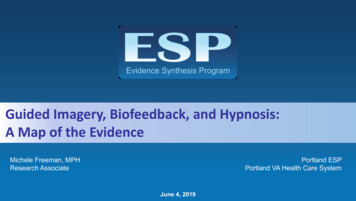
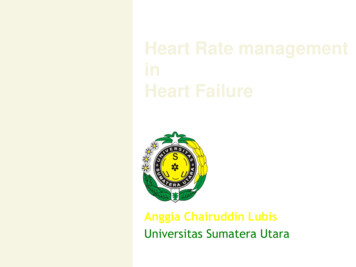

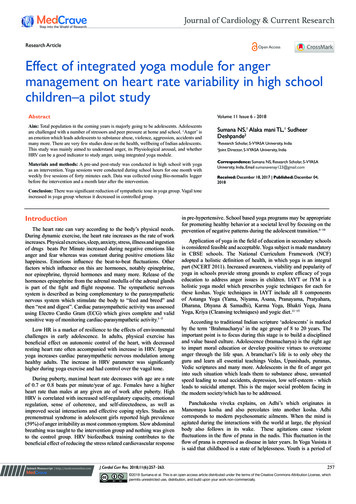

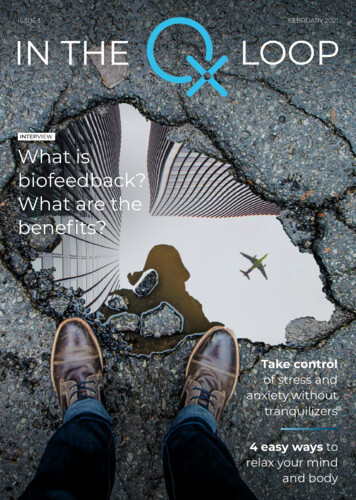
![High Variability [Pronunciation] Training (HVPT)](/img/28/2018thomson-hvpt.jpg)

